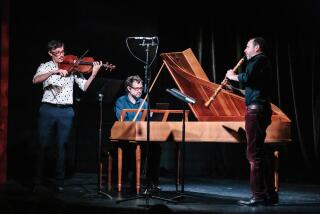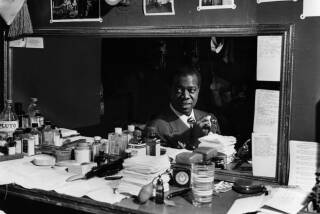Experimental Sax : Jazz Musician Bill Perkins Is Ready to Take Off and Improvise at Fullerton Show
- Share via
The hoarse, breathy voice on the other end of the phone doesn’t sound like Bill Perkins.
“I just had some plaque scraped from my throat,” the 72-year-old sax player explains in whispers from his home in Sherman Oaks. “Nonmalignant. Not a big thing. Just makes it hard to talk.”
Perkins has battled lung cancer in recent years. But the throat scraping “is just a precautionary thing,” he says. “My health is fine, my lungs are very healthy now. And the blowing part is great, really great.”
Indeed, Perkins (who never smoked) has been popping up in clubs all over the L.A. area over the past several months, leading his own combos or appearing as a sideman at Jax in Glendale, Chadney’s in Burbank and the Jazz Bakery in Culver City. Tonight, he joins the Kim Richmond-Clay Jenkins Ensemble at Steamers in Fullerton.
For some 45 years, he has enjoyed a reputation as one of the most enthusiastic and gracious jazz musicians on the West Coast scene. He has worked with some of the biggest names--Woody Herman, Stan Kenton, John Lewis, Shorty Rogers, Toshiko Akiyoshi--and his own recordings (including “On Stage: The Bill Perkins Octet,” recorded in 1956 with Richie Kamuca and Art Pepper; “Quietly There,” a tribute to Johnny Mandel from 1966; and the ambitious “Journey to the East,” from 1984) stand as landmarks. (His latest album is “Perk Plays Prez,” on Fresh Sound Records.)
These accomplishments are especially noteworthy given that Perkins spent the first 10 years of his life in a South American mining town and almost became an electrical engineer.
“Jazz came into my life and situated itself in a devious manner,” he recalls. “Much of it was luck. I didn’t realize what was happening.”
His father was a mining engineer in Chile’s Atacama Desert. “It was the most remote place you can imagine. But my father had a Victrola, and the camp had a school.”
It was there that he started out on piano and then moved to clarinet, which he later dropped in favor of the sax. (“That decision came back to haunt me when I started doing studio work. Technically, clarinet is the most difficult of woodwinds, except for the oboe and bassoon. There aren’t too many good clarinet players.”)
*
After World War II, Perkins seriously considered a degree in electrical engineering, but friends convinced him to stick with music. Rogers got him a last-minute date to play the Los Angeles Palladium with Jerry Wald’s band in 1950. Perkins wound up staying in the band for a year. He then moved on to Herman’s ensemble, and played with Herman and with Kenton’s bands through the ‘50s.
“I was thrown in with Stan’s band (in 1953) without a rehearsal or anything, at a time he was touring with Dizzy Gillespie, Erroll Garner, Slim Gaillard and Stan Getz. I was very lucky to get to meet and talk to players like that.”
Working with Herman and Kenton also gave him insight into how the two bandleaders operated. “Stan was incredibly articulate. He was very much into the intellectualization of jazz. Woody could talk, but he wasn’t a verbal man. He worked more from the gut. Both were driven by strong obsessions. Stan was more Wagnerian in his thinking. He loved that large brass sound. Woody was more straight-ahead. His was more of a swing band.”
Perkins was involved heavily in studio work during the ‘60s, both as player and occasionally as a recording engineer. He began playing with the “Tonight Show” band in 1968 and joined the Toshiko Akiyoshi-Lew Tabackin big band in 1974.
Akiyoshi and Tabackin “started this rehearsal band and all the musicians thought nothing would come of it,” Perkins says. “But by golly, something did. The tenacity of those people astounds me. Her music was not easy to play. Unlike most bandleaders, who write horizontally, she writes vertically, going from one note to another harmonically, like a pianist, not necessarily following a line. It’s very difficult to play. But the result is fantastic.”
*
Perkins has shown amazing versatility over the years, playing baritone in the studios and with Akiyoshi, soprano with the Shorty Rogers-Bud Shank Lighthouse reunion band of the ‘80s, and covering tunes on his own albums from such various sources as Thelonious Monk, Duke Pearson and onetime Miles Davis guitarist Mike Stern.
But “to me,” he says, “playing with a small rhythm section is the highest art. Sure, I played with some big bands, but I really developed playing with rhythm sections where you can really take off and improvise”--which is what he’ll be doing at Steamers tonight. Richmond and Clay “like to experiment. I feel incredibly lucky to be playing with them, and it should be a tremendous growing experience for me.”
* Bill Perkins joins the Kim Richmond-Clay Jenkins Ensemble tonight at Steamers, 138 W. Commonwealth Ave., Fullerton. 8:30 p.m. No cover, two-item minimum. (714) 871-8800.
More to Read
The biggest entertainment stories
Get our big stories about Hollywood, film, television, music, arts, culture and more right in your inbox as soon as they publish.
You may occasionally receive promotional content from the Los Angeles Times.










